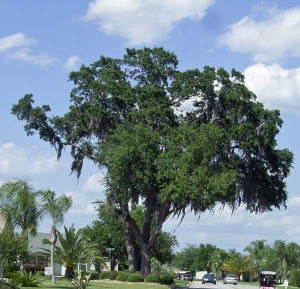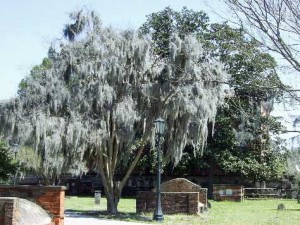Back when I was little, I loved weeping willow trees. I still do, but now, the live oak is my absolute favorite tree. How is it that the same tree, depending on the context, can evoke different emotions? Since there are no live oaks where we live, as soon as I start seeing them on our way south, I feel like I’m almost at my destination. To me, they are as synonymous with the South as palm trees, plantation-style houses and pecan pie.
Yet on a dark and stormy night, the Spanish moss that decorates their branches give me an eerie feeling that reminds me of axe murderers and haunted houses.
Live oaks are actually evergreens, so they don’t lose their leaves in winter. Their branches tend to grow out rather than up and they’re low to the ground, often creating a canopy over a road. One of the most well-known photos of live oaks is that taken on the way to Oak Alley, a plantation near New Orleands, LA.
The cemetery in this photo dates back to the Civil War. The cemetery has stories of its own that I’ll tell you one day in another post.They tell me that Spanish moss doesn’t hurt the trees, but I disagree. It seems to me that when the moss covers the branches, it suffocates the leaves. Where there’s Spanish moss, there are bare branches. Could be that if the moss is removed, the leaves will grow again. I hope so.
Do you have a favorite tree?



My mother minored in botany and did her thesis paper on a type of disease that affected various oak trees.
That’s TMI for me, but I do like learning the names of all the different types of oaks because they seem to be in every city I’ve moved to so far–but in different varieties.
Yes, I too, love Live Oaks and posted about them under O for Oaks! Love your site and blog.